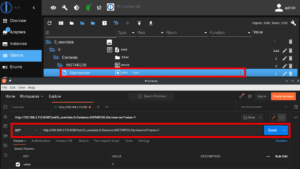A Camera API HTTP request is like a magic spell that makes your camera take pictures from far away, just with a bit of code! Imagine being able to snap a photo without even touching your camera—sounds cool, right? This amazing tool lets you control your camera through the internet, making picture-taking easier and faster.
Using a is not only fun but also super handy. Whether you want to take pictures automatically or control your camera from another city, this tool can do it all. In this blog post, we’ll explore how you can use this powerful tool to boost your app’s performance and make your life easier.
1. What Is a Camera API HTTP Request and How Does It Work?
A Camera API HTTP request is a special way to control a camera using code. It’s like sending a message to the camera, asking it to do something, like take a picture. This is done over the internet, which means you don’t have to be near the camera to control it.
To use a you need a camera that understands these commands. Many modern cameras have this feature. You write a little bit of code, send it to the camera, and the camera follows the instructions. It’s like magic, but with technology!
Understanding how a works is important if you want to make your apps more powerful. It can help you automate tasks, save time, and even control cameras from far away. This makes it a great tool for anyone who loves technology.
2. Top 5 Reasons to Use a Camera API HTTP Request in Your Projects
Using a Camera API HTTP request in your projects can bring many benefits. First, it allows you to automate the process of taking pictures. This is useful if you need to take many pictures quickly without doing it manually.
Another reason to use a is that it lets you control cameras remotely. You can be in a different room, city, or even country, and still take pictures with your camera. This can be very handy in situations where you need to monitor something from a distance.
Using this tool also saves time. Instead of manually clicking the camera button, the does it for you. Finally, it’s easy to learn and implement, making it a valuable skill for any developer.
3. Step-by-Step Guide: How to Set Up a Camera API HTTP Request
Setting up a Camera API HTTP request is easier than it sounds. First, you need to find a camera that can understand these requests. Many new cameras come with this feature, so check the manual or the manufacturer’s website.
Once you have the right camera, the next step is to learn how to send an HTTP request. This involves writing a small piece of code. There are many examples online, so you don’t have to start from scratch. Follow the instructions provided by the camera’s API documentation.
Finally, test your by sending a command to the camera. If everything is set up correctly, the camera will take a picture or perform the action you requested. With practice, you’ll become more comfortable using this powerful tool.
4. Automate Your Picture-Taking with a Camera API HTTP Request
Automation is one of the best features of a Imagine setting up your camera to take pictures automatically at certain times. This can be very useful if you need to capture events over a long period, like time-lapse photography.
To automate picture-taking, you’ll write a small code that tells the camera when to take a picture. The will send this code to the camera, and the camera will follow the instructions without any manual input.
Automation saves you a lot of time and effort. Instead of manually taking each picture, the does it for you. This is especially helpful in professional photography and security monitoring.
5. Control Your Camera from Anywhere with a Camera API HTTP Request
One of the coolest things about a is the ability to control your camera from anywhere. Whether you’re in another room or another city, you can still take pictures or perform other tasks with your camera.
To do this, you need a camera connected to the internet. When you send a the camera receives it and does what you asked, even if you’re far away. This is perfect for situations where you can’t be near the camera but still need to control it.
Remote control through a is not only convenient but also practical. It allows you to monitor things from afar, making it a great tool for security or scientific observation.
6. How to Save Time with a Camera API HTTP Request
Time is precious, and using a can help you save a lot of it. Instead of manually taking pictures, this tool allows you to automate the process. This means your camera can take pictures on its own without you having to press the button each time.
Saving time with a is especially helpful if you need to take many pictures in a short period. It’s also useful in situations where you need to focus on other tasks while your camera does its job automatically.
In the end, the time you save by using an can be spent on more important things. Whether you’re a photographer, developer, or hobbyist, this tool can make your work faster and easier.
7. Easy Example: Writing Your First Camera API HTTP Request Code
Writing your first Camera API HTTP request code might sound hard, but it’s actually quite simple. Let’s start with a basic example. Imagine you want to tell your camera to take a picture. The code might look something like this:
vbnet
Copy code
GET /takePicture HTTP/1.1
Host: mycamera.com
Authorization: Bearer YOUR_ACCESS_TOKEN
This small piece of code is like saying, “Hey camera, please take a picture for me!” When you send this the camera listens and takes the picture. It’s as easy as that!
Starting with simple examples like this helps you understand how a works. As you get more comfortable, you can try more advanced codes and do even cooler things with your camera.
8. Boost Your App’s Functionality Using Camera API HTTP Requests
Adding a to your app can greatly boost its functionality. Imagine an app that can automatically take pictures or videos at the right moment. This makes your app more powerful and useful.
Integrating a is not difficult. You just need to follow the camera’s API instructions and write some code to connect your app to the camera. Once this is done, your app can send requests to the camera and control it.
By using a you make your app more interactive and responsive. It allows users to do more things with the camera, making your app stand out from the rest.
9. Camera API HTTP Request: A Beginner’s Guide
If you’re new to the concept of a Camera API HTTP request, don’t worry! It’s actually quite simple to learn. A Camera API is like a bridge that connects your code to the camera, letting you control it with commands sent over the internet.
To get started, find a camera that supports API requests. Then, learn how to write basic HTTP requests that the camera can understand. This is the foundation of using a.
For beginners, it’s best to start with simple tasks like taking a picture. As you gain more confidence, you can explore more advanced features of the like adjusting camera settings or recording videos.

10. Why Every Developer Should Learn About Camera API HTTP Requests
Learning about is a valuable skill for any developer. It opens up new possibilities for creating apps that interact with cameras, making your projects more dynamic and engaging.
One reason to learn about is that it’s becoming more common in technology. Many modern apps and devices use this feature to offer remote control and automation. Knowing how to implement it gives you an edge in the tech world.
Another reason is that it’s fun and interesting. Controlling a camera with code can be a rewarding experience. It allows you to combine creativity with technical skills, making your work as a developer even more exciting.
11. Common Mistakes to Avoid When Using Camera API HTTP Requests
Using a Camera API HTTP request can be powerful, but there are some common mistakes to watch out for. One mistake is not properly setting up the camera or API. Make sure to follow the instructions carefully to avoid errors.
Another mistake is forgetting to secure your Always use authentication methods, like tokens, to protect your camera from unauthorized access. This keeps your camera safe from potential threats.
It’s also important not to overload your camera with too many requests at once. This can cause the camera to freeze or stop working properly. By avoiding these common mistakes, you can make the most of your experience.
12. Future Trends: How Camera API HTTP Requests Are Changing Photography
The future of photography is being shaped by tools like. These requests allow photographers to control cameras in new and innovative ways, making photography more flexible and creative.
One future trend is the use of AI with Imagine a camera that not only takes pictures on command but also uses AI to enhance them automatically. This combination can lead to stunning photos with less effort.
Another trend is the increased use of remote photography. With photographers can capture images from faraway locations without being there. This opens up new possibilities for exploration and creativity in photography.
13. Troubleshooting Tips for Camera API HTTP Requests
Sometimes, things might not go as planned when using a . Troubleshooting is important to figure out what’s wrong and how to fix it. One common issue is a failed request. This could happen if the camera isn’t properly connected or the code has a mistake.
Another problem could be the camera not responding to the request. This might mean there’s an issue with the camera’s settings. Double-check that everything is configured correctly, and try again.
When troubleshooting, it’s also a good idea to check the camera’s logs if available. These logs can give you clues about what went wrong. With some patience and careful checking, you can usually fix the issues and get your working again.
14. Security Best Practices for Camera API HTTP Requests
Security is crucial when working with a Camera API HTTP request. Since these requests are sent over the internet, they can be vulnerable to unauthorized access if not properly secured. One of the best practices is to use encryption to protect the data being sent.
Always ensure that you use strong authentication methods. For example, API keys or tokens can help ensure that only authorized users can send to your camera. This prevents hackers from gaining control over your camera.
Another security tip is to regularly update your camera’s firmware. Manufacturers often release updates that fix security vulnerabilities. By keeping your camera up to date, you can protect it from potential threats.
15. Exploring Advanced Features with Camera API HTTP Requests
Once you’re comfortable with the basics of Camera API HTTP requests, you can start exploring more advanced features. These features allow you to do more complex tasks, like adjusting camera settings, streaming video, or even controlling multiple cameras at once.
For example, you can use a to change the camera’s exposure or focus settings. This gives you more control over the quality of the images or videos you capture. You can also use it to start and stop video recordings.
Advanced features might take some time to learn, but they can greatly enhance your camera’s capabilities. With practice, you can use these features to create more sophisticated and professional projects.
16. How to Integrate Camera API HTTP Requests into Your Workflow
Integrating Camera API HTTP requests into your daily workflow can make your tasks more efficient. If you’re a photographer or developer, this tool can automate routine tasks, saving you time and effort. For example, you can set up your camera to automatically take pictures at regular intervals.
To integrate into your workflow, start by identifying tasks that can be automated. Then, write the necessary code to send the HTTP requests. You can even schedule these requests to run at specific times, ensuring that your camera operates without manual input.
Once integrated, can streamline your work and allow you to focus on more creative or important tasks. This makes it a valuable addition to any professional’s toolkit.
17. Real-World Applications of Camera API HTTP Requests
Camera API HTTP requests have many real-world applications. One common use is in security systems. Cameras in these systems often rely on HTTP requests to capture images or stream video when motion is detected. This makes monitoring areas easier and more efficient.
Another application is in wildlife photography. Researchers can use Camera API HTTP requests to control cameras placed in remote locations. This allows them to capture images of animals in their natural habitats without disturbing them.
In addition, are used in smart homes. Cameras can be programmed to take pictures or videos based on specific triggers, such as when someone rings the doorbell. These real-world applications demonstrate the versatility and power of this technology.
18. Comparing Camera API HTTP Requests with Other Camera Control Methods
When it comes to controlling a camera, there are several methods available. are one of the most flexible and powerful options. They allow you to control your camera remotely and automate tasks, which is not possible with traditional methods like physical buttons or remote controls.
Compared to other methods, offer greater precision. You can send specific commands that the camera follows exactly, making it ideal for complex tasks. Additionally, this method integrates well with other technologies, like mobile apps or cloud services.
While other control methods might be simpler, they lack the advanced features and flexibility of. For those who need more control and automation, this method is often the best choice.
19. Common Use Cases for Camera API HTTP Requests
There are many common use cases for. For instance, they are widely used in surveillance systems. Security cameras can automatically capture images or videos when motion is detected, and these actions are often triggered by an HTTP request.
Another common use is in time-lapse photography. By setting up a series of intervals over a long period. This is perfect for capturing events that unfold slowly, like a flower blooming or a sunset.
are also used in remote monitoring. Whether for scientific research or security, these requests allow cameras to be controlled from afar. This makes them an essential tool in many different fields.
20. The Role of Camera API HTTP Requests in IoT Devices
In the world of the Internet of Things (IoT), play a significant role. IoT devices often rely on these requests to communicate with cameras. For example, a smart doorbell might use an HTTP request to trigger the camera when someone approaches.
These requests are also used in smart homes. Cameras can be integrated into home automation systems, taking pictures or recording videos based on triggers like motion detection or voice commands. make this integration possible.
As IoT devices become more common, the use of is likely to grow. They offer a reliable and efficient way to control cameras and capture important data in a connected world.

conclusion:
using Camera API HTTP requests can make controlling your camera easier and more powerful. Whether you want to take pictures, record videos, or adjust settings from far away, these requests help you do it all with just a few lines of code. They are great for both beginners and professionals who want to get the most out of their cameras.
As you’ve seen, there are many ways to use in your projects. From security systems to wildlife photography, this technology opens up many possibilities. By learning how to use these requests, you can improve your workflow and create amazing things with your camera.









